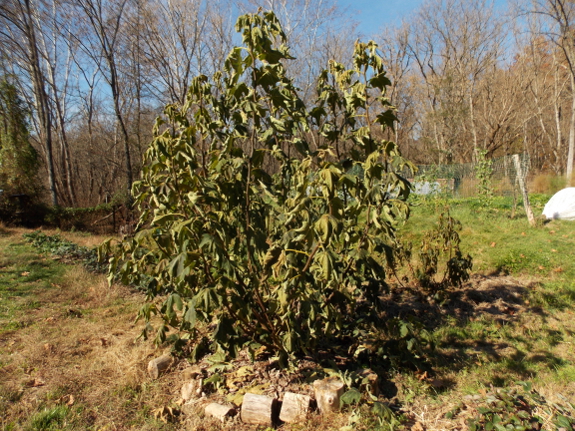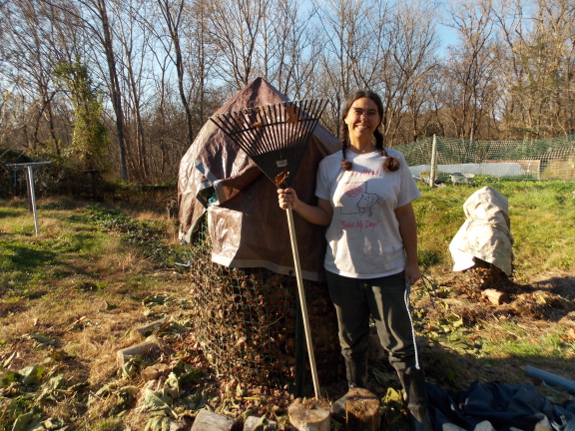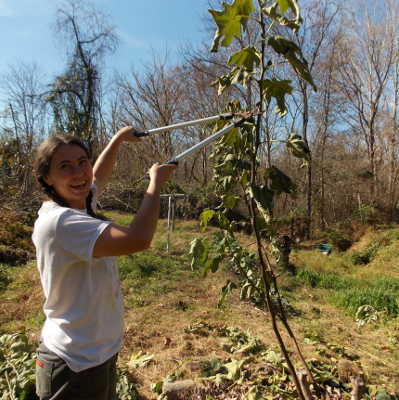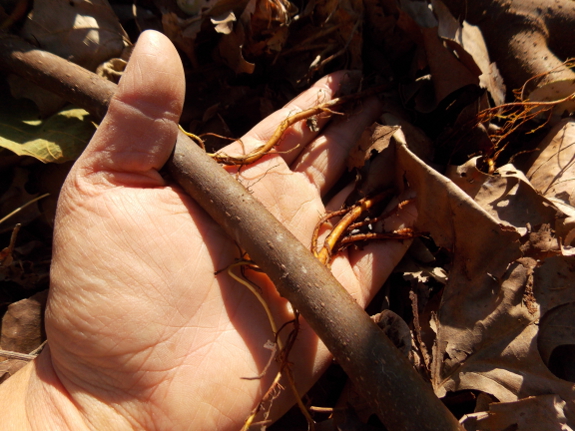
Protecting a fig from winter cold

Even though it was hard
to believe when I stripped down to a t-shirt five hours later, we had a
low of 21 on Sunday night. The killing frost was definitely enough to
nip our fig leaves and put the tree to sleep, which meant it was time to
protect our fig from winter cold.
Regular readers will
probably know all about our fig trees (which I talk about almost as much
as cute goats). But if you're new, here are some answers to obvious
questions:
- Some fig varieties are hardy to zone 6 (with winter protection).
- General tips on protecting figs through the winter.
- Protecting a small fig tree.
Result: This was not sufficient to help summer-planted figs survive
during the ultra-cold winter last year, but it worked in other years and
on older figs.
- My 2012 method of protecting a large fig tree. Result: The tarp on top slid to the side and the leaves matted down, but it worked pretty well otherwise.
- My 2013 method of protecting a large fig tree. Result: Last winter was awfully cold, so it's hard to tell whether this method was worse or not. It definitely wasn't better.

 Okay,
now that you're all up to speed, it's time to protect that fig! I opted
to return to the 2012 method, figuring that more leaves around the base
of the plant will protect the sensitive junction of stem and root from
winter injury. Brian suggested stones around the base, which is a great
idea, but I never seem to have extra rocks to throw around. (It's a
momentous occasion when a new stone turns up in the garden.) Assuming we
don't have a repeat of last year's ultra-cold winter, and assuming that
I secured the tarp well enough, hopefully the three stems I kept will
produce an early crop (which we missed out on this year).
Okay,
now that you're all up to speed, it's time to protect that fig! I opted
to return to the 2012 method, figuring that more leaves around the base
of the plant will protect the sensitive junction of stem and root from
winter injury. Brian suggested stones around the base, which is a great
idea, but I never seem to have extra rocks to throw around. (It's a
momentous occasion when a new stone turns up in the garden.) Assuming we
don't have a repeat of last year's ultra-cold winter, and assuming that
I secured the tarp well enough, hopefully the three stems I kept will
produce an early crop (which we missed out on this year).

As I pruned, I was
excited to see that several of the small stems that had grown
horizontally out from the tree base had sprouted roots over the summer! I
snipped the rooted segments off and wrapped them in damp newspaper in
case any of our readers want to give Chicago Hardy figs a try. Enter the
giveaway using the widget below if you're interested (and be sure to
plan ahead for five cuttings that should be potted up and spend the
winter in a cool spot inside while they finish growing roots).
Want more in-depth information? Browse through our books.
Or explore more posts by date or by subject.
About us: Anna Hess and Mark Hamilton spent over a decade living self-sufficiently in the mountains of Virginia before moving north to start over from scratch in the foothills of Ohio. They've experimented with permaculture, no-till gardening, trailersteading, home-based microbusinesses and much more, writing about their adventures in both blogs and books.
Want to be notified when new comments are posted on this page? Click on the RSS button after you add a comment to subscribe to the comment feed, or simply check the box beside "email replies to me" while writing your comment.

I'm concerned about soil quality. As you know, the Tri-Cities area doesn't really have soil - we've got clay, which is good for making bricks and pots but not so good for most plants. Do you have mostly clay soil and if so, do you add any kind of amendments, or do you have very nice loamy soil?
Thanks
Susan --- I'll be curious to hear how your experiment turns out!
Rae --- That's a good question! Our Chicago Hardy fruited for the first time when it had been in the ground a year and a half. Of course, that wasn't from a cutting, so I'd add 1 to 2 years on top of that for serious fruit. That said, I gave my mom one of last year's cuttings...and she had fruit this summer! She lives one zone warmer than me, though, which I think helped.